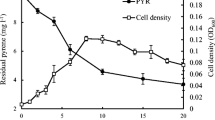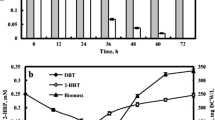Abstract
Nitroaromatic compounds are major chemical pollutants because of their widespread use and toxicity. Bioremediation of such toxic nitroaromatic compounds using microorganisms may provide an effective method for detoxification. Bacillus flexus strain XJU-4, capable of degrading 3-nitrobenzoate, was immobilized in various matrices, namely polyurethane foam (PUF), polyacrylamide, sodium alginate (SA), sodium alginate-polyvinyl alcohol (SA-PVA) and agar. The degradation of 12 and 24 mM 3-nitrobenzoate, by both freely suspended cells and immobilized cells, in batches and fed-batch with shaken cultures were compared. The PUF-immobilized cells achieved higher degradation rates of 12 and 24 mM — nitrobenzoate than freely suspended cells, and the cells immobilized in SA-PVA, polyacrylamide, SA and agar. The PUF-immobilized cells could be reused for more than 21 cycles without losing any degradation capacity. These results revealed the feasibility of using PUF-immobilized cells of B. flexus for the enhanced degradation of — nitrobenzoate.
Similar content being viewed by others

References
Kulkarni, M. and A. Chaudhari (2007) Microbial remediation of nitro-aromatic compounds: An overview. J. Env. Management 85: 496–512.
Ghosh, A., M. Khurana, A. Chauhan, M. Takeo, A. K. Chakraborti, and R. K. Jain (2010) Degradation of 4-nitrophenol, 2-chloro-4-nitrophenol and 2,4-dinitrophenol by Rodococcus imtechensis Strain RK300. Env. Sci. Technol. 44: 1069–1077.
Rieger, P. G., H. M. Meler, M. Gerle, U. Vogt, T. Groth, and H. J. Knackmuss (2002) Xenobiotics in the environment: Present and future stratergies to obviate the problem of biological persistence. J. Biotechnol. 94: 101–123.
Higson, F. K. (1992) Microbial degradation of nitroaromatic compounds. Adv. Appl. Microbiol. 37: 1–19.
Nipper, M., R. S. Carr, J. M. Biedenbach, R. L. Hooten, K. Miller, and S. Saepoff (2001) Development of marine toxicity data for ordnance compounds. Arch. Environ. Contam. Toxicol. 41: 308–318.
Tokiwa, H. and Y. Ohnishi (1986) Mutagenicity and carcinogenicity of nitroarenes and their sources in the environment. CRC. Crit. Rev. Toxicol. 17: 23–60.
Nishino, S. F., J. C. Spain, and Z. He (2000) Strategies for aerobic degradation of nitroaromatic compounds by bacteria: Process discovery to field application. pp. 7–61. In: J. C. Spain, J. B. Hughes, and H. -J. Knackmuss (eds.). Biodegradation of Nitroaromatic Compounds and Explosives. Lewis Publishers Boca Raton.
Pandey, G., D. Paul, and R. K. Jain (2003) Branching of onitrobenzoate degradation pathway in Arthrobacter protophormiae RJK 100: Identification of new intermediates. FEMS. Microbiol. Lett. 229: 231–236.
Ye, J., A. Sing, and O. Ward (2004) Biodegradation of nitroaromatic compounds and other nitrogen-containing xenobiotics. World J. Microbiol. Biotechnol. 20: 117–135.
Jiyeon, H., R. C. Engler, and J. R. Wild (2009) Biodegradation of coumaphos, chlorferon, and diethylthiophosphate using bacteria immobilized in Ca-alginate gel beads. Bioresour. Technol. 100: 1138–1142.
Trevors, J. T., H. Lee, A. C. Wolters, and J. D. VanElsas (1993) Survival of alginate encapsulated Pseudomonas fluorescens cells in soil. Appl. Microbiol. Biotechnol. 39: 637–643.
Zheng, C., J. Zhou, J. Wang, B. Qu, J. Wang, H. Lu, and H. Zhao (2009) Aerobic degradation of nitrobenzene by immobilization of Rhodotorula mucilaginosa in polyurethane foam. J. Haz. Mat. 168: 298–303.
Chung, T. P., H. Y. Tseng, and R. S. Juang (2003) Mass transfer effect and intermediate detection for phenol degradation in immobilized Pseudomonas putida systems. Proc. Biochem. 38: 1497–1507.
Tallur, P. N., V. B. Megadi, and H. Z. Ninnekar (2009) Biodegradation of p-cresol by immobilized cells of Bacillus sp. strain PHN 1. Biodegradation 20: 79–83.
Cheethman, P. S. J. (1980) Immobilized enzymes. pp. 189–238. In: P. S. J. Cheetam (eds.). Topics in enzyme and fermentation technology. Hills Harwood, Chichester.
Kotouckova, L., J. Vavrik, M. Nemec, J. Plocek, and Z. Zdrahal (1997) Use of immobilized cells of the strain Corynebacterium sp. for 4-nitrophenol degradation. Folia. Microbiol. 42: 509–512.
Kitova, A. E., T. N. Kuvichkina, A. Y. Arinbasarova, and A. N. Reshetilov (2004) Degradation of 2,4-dinitrophenol by free and immobilized cells of Rhodococcus erythropolis HL PM-1. Appl. Biochem. Microbiol. 40: 258–261.
Peres, C. M., H. B. VanAken, H. Naveau, and S. N. Agathos (1999) Continuous degradation of mixtures of 4-nitrobenzoate and 4-aminobenzoate by immobilized cells of Burkholderia cepacia strain PB4. Appl. Microbiol. Biotechnol. 52: 440–445.
Goodall, J. L., S. M. Thomas, J. C. Spain, and S. W. Peretti (1998) Operation of mixed-culture immobilized cell reactors for the metabolism of meta- and para-nitrobenzoate by Comamonas sp. JS46 and Comamonas sp. JS47. Biotechnol. Bioeng. 59: 21–27.
Zhang, K., Y. Xu, X. Hua, H. Han, J. Wang, J. Wang, Y. Liu, and Z. Liu (2008) An intensified degradation of phenanthrene with macroporous alginate-lignin beads immobilized Phanerochaete chrysosporium. Biochem. Eng. J. 41: 251–257.
Mulla, S. I., R. S. Hoskeri, Y. S. Shouche, and H. Z. Ninnekar (2011) Biodegradation of 2-nitrotoluene by Micrococcus sp. strain SMN-1. Biodegradation 22: 95–102.
Mulla, S. I., T. P. Manjunatha, R. S. Hoskeri, P. N. Tallur, and H. Z. Ninnekar (2011) Biodegradation of 3-nitrobenzoate by Bacillus flexus strain XJU-4. World J. Microbiol. Biotechnol. 27: 1587–1592.
Hall, D. O. and K. K. Rao (1989) Immobilized photosynthetic membranes and cells for the production of fuels and chemicals. Chim. Oggi. 1: 41–47.
Bettmann, H. and H. J. Rehm (1984) Degradation of phenol by polymer entrapped microorganisms. Appl. Microbiol. Biotechnol. 20: 285–290.
Wang, B. -E. and Y. -Y. Hu (2007) Comparison of four supports for adsorption of reactive dyes by immobilized Aspergillus fumigates beads. J. Env. Sci. 19: 451–457.
Jonathan, M. (1988) Methods of immobilization of microbial cells. J. Microbiol. Methods. 8: 91–102.
Cassidy, M. B., H. Lee, and J. T. Trevors (1996) Environmental applications of immobilized microbial cells: A review. J. Ind. Microbiol. 16: 79–101.
Yun, Q., Z. Lin, and T. Xin (2009) Cometabolism and immobilized degradation of monochlorobenzoate by Rhodococcus erythropolis. Afr. J. Microbiol. Res. 3: 482–486.
Trevors, J. T., J. P. VanElsa, H. Lee, and L. S. VanOverbeek (1992) Use of alginate and other carriers for encapsulation of microbial cells for use in soil. Microb. Rel. 1: 61–69.
Quek, E., Y. -P. Ting, and H. M. Tan (2006) Rhodococcus sp. F92 immobilized on polyurethane foam shows ability to degrade various petroleum products. Bioresour. Technol. 97: 32–38.
Romaskevic, T., S. Budriene, K. Pielichowski, and J. Pielichowski (2006) Application of polyurethane-based materials for immobilization of enzymes and cells: A review. CHEMIJA. 17: 74–89.
Author information
Authors and Affiliations
Corresponding author
Rights and permissions
About this article
Cite this article
Mulla, S.I., Talwar, M.P., Hoskeri, R.S. et al. Enhanced degradation of 3-nitrobenzoate by immobilized cells of Bacillus flexus strain XJU-4. Biotechnol Bioproc E 17, 1294–1299 (2012). https://doi.org/10.1007/s12257-012-0211-2
Received:
Revised:
Accepted:
Published:
Issue Date:
DOI: https://doi.org/10.1007/s12257-012-0211-2



